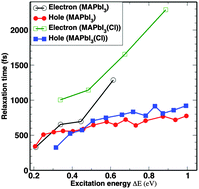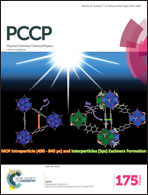Enhancing the carrier thermalization time in organometallic perovskites by halide mixing†
Abstract
Hybrid metal–organic halide perovskites have recently attracted a great deal of attention because of their interesting electronic, optical and transport properties, which make them promising materials for high-performance, low-cost solar cells. Fundamental understanding of the formation mechanisms and dynamics of photoinduced charge carriers is essential for improving the performance of perovskite solar cell devices. For example, a significant amount of absorbed solar energy is lost as a result of carrier thermalization. This energy could be harnessed by extracting hot carriers before they cool down to the band edges. Although such hot carrier collection is experimentally challenging, theoretical investigations based on time-dependent methods can guide future experimental research by providing insights into the thermalization process. Here, we perform ab initio nonadiabatic molecular dynamics simulations to study non-radiative relaxation dynamics of charge carriers in hybrid halide perovskites. We find that the carrier relaxation time can be considerably increased by mixing halogen atoms in the perovskite materials. These findings show that simple approaches could be adopted to slow down the thermalization process of hot carriers in perovskite materials.



 Please wait while we load your content...
Please wait while we load your content...